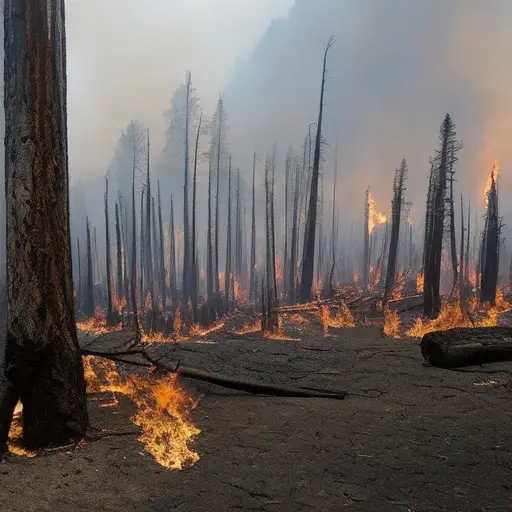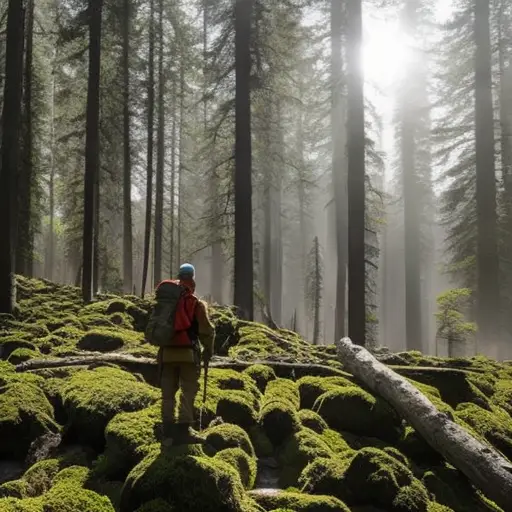Understanding the Impact of Fires on the Ecosystem

In the wake of recent devastating wildfires, there is a pressing need to comprehend the profound consequences of these events on our delicate ecosystem. Like a raging inferno, fires leave behind a trail of destruction, annihilating vegetation and disrupting the intricate web of life.
This article delves into the scientific realm, objectively examining the impact of fires on the environment. By unraveling the intricate connections between fire and the ecosystem, we can better understand the challenges faced in its recovery.
Immediate Destruction of Vegetation
Fires rapidly devastate vegetation, causing immediate destruction and altering the ecosystem’s dynamics. The impacts on soil health and the regeneration of plant communities are significant consequences of this destruction. When fires occur, the intense heat can lead to the combustion of organic matter, resulting in the release of nutrients stored in the vegetation. This process, known as mineralization, can have both positive and negative effects on soil health.
On one hand, the release of nutrients from burned vegetation can enhance soil fertility, promoting the growth of new plant communities. The increased availability of nutrients, such as nitrogen and phosphorus, can stimulate the establishment of pioneer species that are well-adapted to post-fire conditions. These plants play a crucial role in the early stages of ecosystem recovery, as they stabilize the soil, prevent erosion, and facilitate the establishment of other plant species.
On the other hand, the immediate destruction of vegetation by fires can have negative consequences for soil health. The loss of plant cover exposes the soil to increased erosion and the leaching of nutrients, which can lead to nutrient depletion and reduced fertility. Additionally, the combustion of organic matter releases large amounts of carbon dioxide into the atmosphere, contributing to climate change and altering the global carbon cycle.
Loss of Habitat for Wildlife
The loss of habitat for wildlife is a significant consequence of fires in ecosystems. These fires can displace wildlife from their natural habitats, forcing them to seek alternative locations for survival.
Additionally, the destruction of vegetation caused by fires can disrupt the food chain and availability of resources, leading to a long-term impact on the recovery of affected species.
Understanding how fires affect wildlife habitat is crucial for implementing effective conservation strategies.
Wildlife Displacement After Fires
After fires, wildlife often experience displacement due to the loss of their natural habitats. This displacement can have significant consequences for the affected species and their overall ecosystem.
Wildlife rehabilitation becomes crucial in such situations to mitigate the negative impact of fire on wildlife populations. Efforts are made to provide temporary shelter, food, and water sources for displaced animals.
In addition to rehabilitation, fire management strategies play a vital role in protecting wildlife habitats. Prescribed burns and controlled fire suppression techniques can help prevent large-scale fires and minimize habitat destruction. These strategies aim to maintain the ecological balance, ensuring that wildlife can recover and reclaim their habitats after fires.
Recovery of Affected Species
Wildlife populations affected by fires must undergo a process of habitat recovery to restore their ecosystems.
Habitat restoration is crucial for the recovery of affected species and the overall health of the ecosystem.
After a fire, the loss of habitat for wildlife can result in population decline or displacement. However, with time and suitable conditions, affected species can recover and repopulate the area.
The recovery process involves the restoration of the vegetation and the availability of food and shelter for the wildlife.
It is essential to prioritize the conservation of surviving individuals and their habitats to facilitate population recovery.
Monitoring the recovery progress and implementing management strategies are vital to ensure the successful restoration of the affected species and their ecosystems.
Changes in Species Composition
Changes in species composition following wildfires are a natural and dynamic process known as post-fire species succession. This process involves the establishment and growth of different plant and animal species in a fire-affected area.
Wildfires can result in changes to the overall biodiversity of an ecosystem, with some species benefiting from the disturbance and others being negatively impacted. Understanding the patterns and drivers of post-fire species succession is crucial for effective fire management and conservation efforts.
Post-Fire Species Succession
The ecosystem’s species composition undergoes significant changes in the aftermath of a fire, illustrating the profound impact fires have on the ecosystem. Post-fire species succession refers to the predictable patterns of species replacement that occur following a fire event. This process is driven by a combination of factors, including the availability of resources, environmental conditions, and the ability of species to colonize and establish in the disturbed area.
-
Succession patterns:
-
Pioneer species, such as grasses and shrubs, are typically the first to colonize the burned area.
-
As time progresses, these pioneers are gradually replaced by more shade-tolerant species, such as small trees and shrubs.
-
Ecological resilience:
-
Post-fire species succession is an essential mechanism for the ecosystem to recover and regain its ecological resilience.
-
The ability of the ecosystem to bounce back and restore its normal functioning depends on the successful establishment of a diverse range of species.
Understanding post-fire species succession is crucial for managing and conserving ecosystems affected by wildfires. It provides insights into the recovery process and helps identify management strategies to enhance biodiversity after wildfires.
Biodiversity After Wildfires
After a fire, the species composition of the ecosystem undergoes significant changes, leading to shifts in biodiversity. Fires can have both positive and negative effects on biodiversity, depending on the severity and frequency of the fire, as well as the specific characteristics of the ecosystem. Some species may be more resilient to fire and are able to adapt and survive, while others may be less equipped to withstand the disturbance.
Ecological resilience plays a crucial role in determining the impact of fires on biodiversity. Certain species have evolved to be fire-adapted, possessing traits that allow them to thrive in post-fire environments. These fire-adapted species often have characteristics such as thick bark, serotinous cones, or the ability to resprout from underground structures. These adaptations enable them to quickly recolonize burned areas and maintain biodiversity.
The presence of fire-adapted species after a fire can contribute to the restoration and recovery of the ecosystem. However, the loss of non-fire-adapted species can also occur, leading to a decline in overall biodiversity. The balance between these two outcomes depends on the severity and frequency of the fire, as well as the ability of non-fire-adapted species to recolonize the area.
In the subsequent section, we will explore another significant impact of fires on the ecosystem: the disruption of nutrient cycling.
Disruption of Nutrient Cycling
A significant reduction in nutrient cycling occurs following fires, leading to a disruption in the ecosystem’s overall nutrient balance. Fires have a profound impact on soil fertility, causing nutrient depletion and altering the availability of essential elements for plant growth. This disruption in nutrient cycling arises from various factors:
-
Loss of organic matter: Fires consume organic material, including dead plants and animals. This results in a reduction of organic matter in the soil, which serves as a vital source of nutrients. The decline in organic matter limits the availability of essential nutrients for plants to uptake, negatively impacting their growth and overall ecosystem productivity.
-
Leaching and erosion: Fires can increase the risk of soil erosion and leaching. The intense heat from fires can destroy the protective vegetation cover, making the soil vulnerable to erosion by wind and water, leading to the loss of nutrients through runoff. Additionally, the high temperatures can alter the chemical composition of the soil, making it less capable of retaining nutrients.
The disruption of nutrient cycling following fires has substantial consequences for the ecosystem. It can lead to reduced plant productivity, hinder the establishment of new vegetation, and affect the overall composition and diversity of plant communities. Understanding the impact of fires on nutrient cycling is crucial for developing effective strategies to restore and rehabilitate fire-affected ecosystems.
Impact on Air and Water Quality
Fires have a detrimental effect on the quality of both air and water in the ecosystem. The combustion of organic matter during fires releases various pollutants into the atmosphere, including carbon monoxide, nitrogen oxides, and particulate matter. These pollutants can pose serious risks to human health, leading to respiratory problems, cardiovascular diseases, and even premature death.
Additionally, the deposition of these pollutants onto bodies of water can contaminate water sources, affecting aquatic ecosystems and potentially harming human populations that rely on these water sources for drinking and irrigation.
Furthermore, fires can also have long-lasting impacts on air and water quality. The release of greenhouse gases, such as carbon dioxide and methane, contributes to the exacerbation of climate change, leading to further environmental and health concerns.
However, efforts are being made to mitigate these effects and restore the affected ecosystems. Environmental restoration efforts include reforestation programs, which aim to replant vegetation and restore the natural habitat. Additionally, measures are being taken to monitor air and water quality, implementing strategies to reduce pollution levels and protect both the environment and human health.
Long-Term Effects on Ecosystem Recovery
The long-term effects of fires on ecosystem recovery can be significant and multifaceted. Understanding these effects is crucial for managing and restoring fire-affected areas.
Here are some key points to consider:
-
Long term ecological consequences:
- Fires can lead to changes in vegetation composition and structure, affecting biodiversity and ecosystem function.
- Some species may decline or disappear, while others may benefit from the post-fire conditions, leading to altered species interactions.
-
Ecosystem resilience and adaptation:
- Ecosystems have varying degrees of resilience to fire, which is their ability to recover and return to a pre-fire state.
- Fires can also act as natural disturbances that promote ecosystem adaptation. For example, certain plant species have evolved to be fire-adapted, relying on fire to trigger seed germination or stimulate new growth.
Understanding the long-term effects of fires on ecosystem recovery is essential for guiding post-fire management strategies. This knowledge can help in prioritizing conservation efforts, identifying areas for restoration, and implementing appropriate management practices.
Frequently Asked Questions
How Do Fires Affect the Soil Structure and Fertility in the Affected Areas?
Fires have significant effects on soil structure and fertility in affected areas. They can alter the physical properties of soil, such as compaction and water-holding capacity, and also disrupt the microbial community, leading to changes in nutrient cycling and soil erosion.
Are There Any Specific Plant Species That Are More Resilient to Fires and Can Quickly Recolonize Burnt Areas?
Resilient plant species with the ability to quickly recolonize burnt areas play a crucial role in post-fire ecosystem recovery. Understanding the characteristics of these species can aid in the development of effective strategies for ecosystem restoration and management.
What Are the Potential Impacts of Fires on Aquatic Ecosystems, Including Rivers, Lakes, and Wetlands?
Fires can have significant impacts on aquatic ecosystems, including rivers, lakes, and wetlands. They can disrupt fish populations by destroying habitat and reducing food availability. Additionally, fires can lead to increased sedimentation and nutrient runoff, negatively affecting water quality.
How Do Fires Affect the Population Dynamics of Wildlife Species, Including Their Migration Patterns and Reproductive Behaviors?
Fires have significant impacts on wildlife population dynamics, including migration patterns and reproductive behaviors. Understanding these effects is crucial for effective conservation management and mitigation strategies.
Are There Any Long-Term Effects of Fires on the Genetic Diversity of Plant and Animal Populations in the Affected Areas?
The long-term effects of fires on the genetic diversity of plant and animal populations in affected areas are important to understand in terms of long-term adaptation and post-fire recovery. It is necessary to investigate the extent to which fires impact genetic diversity and how populations may respond over time.
Conclusion
In conclusion, fires have significant and far-reaching impacts on ecosystems. They immediately destroy vegetation, leading to the loss of habitat for wildlife. The changes in species composition and disruption of nutrient cycling further exacerbate the effects.
Additionally, fires have a detrimental impact on air and water quality. The release of smoke and pollutants into the atmosphere can cause respiratory problems and contribute to air pollution. The runoff of ash and debris into water bodies can lead to water contamination, affecting aquatic life and potentially human health.
The long-term effects on ecosystem recovery are extensive. It can take years, if not decades, for vegetation to fully regenerate after a fire. The loss of plant cover also increases the risk of erosion and soil degradation, further complicating the recovery process.
One striking statistic is that wildfires in the United States alone have burned an average of 7 million acres annually in the past decade, highlighting the urgent need for effective fire management strategies. These strategies should focus on prevention, early detection, and rapid response to minimize the impacts of fires on ecosystems and human communities.
Overall, understanding the impacts of fires on ecosystems is crucial for developing effective strategies to mitigate their effects and promote ecosystem resilience.



